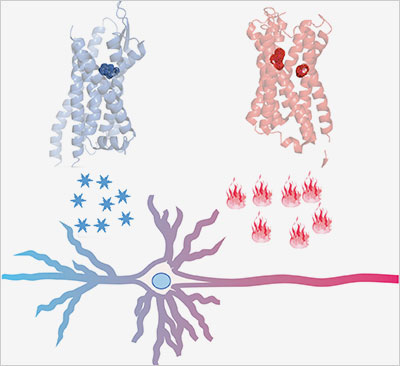Using a new ‘chemogenetic’ technique invented at UNC, scientists turn neurons ‘on’ and ‘off’ to demonstrate how brain circuits control behavior in mice. This unique tool – the first to result from the NIH BRAIN Initiative – will help scientists understand how to modulate neurons to more effectively treat diseases.

CHAPEL HILL, NC – Researchers at the University of North Carolina School of Medicine and the National Institutes of Health (NIH) have perfected a noninvasive “chemogenetic” technique that allows them to switch off a specific behavior in mice – such as voracious eating – and then switch it back on. The method works by targeting two different cell surface receptors of neurons that are responsible for triggering the specific chemical signals that control brain function and complex behaviors.
When this complex signaling system goes awry, the results can lead to a plethora of diseases, including schizophrenia, depression, Alzheimer’s Disease, Parkinson’s Disease, eating disorders, and epilepsy. Cell surface receptors also play roles in cancers, diabetes, digestive conditions, and other diseases. This new technique could be modified to study them, as well.
This is the first technology to stem from the initial set of NIH BRAIN Initiative grants to create new cutting-edge research tools to improve our understanding of the brain.

Essentially, in lab experiments, Roth’s team altered the chemical structure of G protein-coupled receptors so that the receptors expressed synthetic proteins when reintroduced into a mouse. This way, the mutated receptor could only be activated or inhibited by a specific synthesized drug-like compound. The receptor became like a lock; the synthetic drug became the only key that fit the lock. Depending on what Roth’s team wanted to study, they could lock or unlock the specific brain circuits and behaviors associated with that one receptor. (~ above are excerpts from SOM News article by Mark Derewicz, April 30, 2015)
The technique used to control neurons is called DREADDs (designer receptors exclusively activated by designer drugs).
The original DREADDs which were developed in 2007 could only affect the neuron in one way, either on or off. The new DREADDs 2.0 improves on the original version by being able to both activate and inactivate neurons.
Read the full article on UNC School of Medicine News
Read the NIH Press Release article
Read the original article published online April 30, 2015 in the journal, Neuron.
 |
 |
 |
 |
Other UNC authors are Eyol Vardy, co-first author of the Neuron paper, who is now a senior scientist at Merck Pharmaceuticals; Elliot Robinson, MD/PhD student and co-first author on the paper, who conducted his experiments while in the lab of CJ Malanga, PhD, associate professor of neurology and paper co-author; Juan Song, assistant professor of pharmacology and paper co-author; Reid Olsen, graduate student in Dr. Song’s lab and paper co-author, and Thomas Kash, assistant professor of pharmacology and paper co-author.
